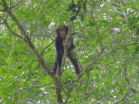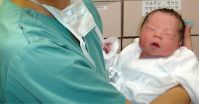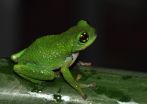(Press-News.org) This news release is available in German.
How do our close relatives, the chimpanzees, acquire sufficient food when times are lean? By studying wild chimpanzees in the Taï National Park in Côte d'Ivoire researchers of the Max Planck Institute for Evolutionary Anthropology in Leipzig, Germany, provide a clear example of how great apes can acquire extra energy needed to maintain large, costly brains. They show that chimpanzees make their sleeping nests more en route to breakfast sites containing fruits that are more competed for by other daytime fruit-eaters than other fruits. Moreover, the researchers found that they leave their nest earlier (and often in the dark when leopards are more likely to attack) for these fruits in order to arrive before others, especially when the breakfast sites were far away.
Not all tropical fruits are equally desired by rainforest foragers and some fruit trees get depleted more quickly and carry fruit for shorter periods than others. Researchers from the Max Planck Institute for Evolutionary Anthropology have now investigated whether a ripe-fruit specialist, the chimpanzee, arrived earlier at breakfast sites with very ephemeral and highly sought-after fruit, like figs, than sites with less short-lived fruit that can be more predictably obtained throughout the entire day.
To this aim Karline Janmaat and her colleagues recorded when and where five adult female chimpanzees spent the night and acquired food for a total of 275 full days during three fruit-scarce periods in the west-African Taï National Park in Côte d'Ivoire. The researchers found that chimpanzees left their sleeping nests earlier (often before sunrise when the forest is still dark) when breakfasting on very ephemeral fruits, especially when they were further away. "It was thrilling to see chimpanzee mums and their young carefully treading the forest floor during twilight, behaving skittish and on guard while moving towards their early morning breakfast figs. One fifth of these mornings they left before sunrise and the rest of the forest seemed sound asleep", says Karline Janmaat. "It got even more exciting when our analyses indicated that they were departing earlier when the figs were far away and that the females were likely making up for travel time to arrive before competitors!"
Furthermore, the researchers found that the females positioned their sleeping nests more in the direction of the next day's breakfast sites with ephemeral fruit compared to breakfast sites with other fruit. By analysing departure times and nest positioning as a function of fruit type and location, while controlling for more parsimonious explanations such as weather conditions, they found evidence that wild chimpanzees flexibly plan their breakfast time, type and location after weighing multiple disparate pieces of information. "When following chimpanzees in the forest, I have always had the feeling they know much more than me. This study helps to clarify some parts of this feeling; chimpanzees before making their night nests to sleep were as well planning for their breakfast tree the next morning!", says Christophe Boesch, director of the Department of Primatology at the Max Planck Institute for Evolutionary Anthropology.
The study reveals a cognitive mechanism by which large-brained primates can buffer the effects of seasonal declines in food availability and increased inter-specific competition to facilitate first access to nutritious food. This may have been particularly important for hominoids, like early humans, that specialized on stationary, energy-rich and highly ephemeral food, such as ripe fruit, abandoned meat carcasses or aquatic fauna trapped in receding waters. "Long -term, detailed information from the field can reveal the value of high levels of cognition and behavioural flexibility for efficiently obtaining critical food resources in complex environments. Being able to reveal how environmental complexity can shape cognitive based behaviour is especially exciting", says co-author Leo Polansky.
INFORMATION:
Karline R. L. Janmaat, Leo Polansky, Simone D. Ban, and Christophe Boesch
Wild chimpanzees plan their breakfast time, type and location
PNAS, 27 October 2014
The early chimp gets the fig
Wild chimpanzees plan their breakfast time, type and location
2014-10-28
ELSE PRESS RELEASES FROM THIS DATE:
Lessons learned from SARS pandemic should inform current contagion protocols
2014-10-28
In 2003, a novel coronavirus caused a pandemic that affected 26 countries. Severe Acute Respiratory Syndrome (SARS) was most prevalent in Asia; the number of cases in Singapore was second only to China.
In an article published in the American Journal of Roentgenology (AJR), a group of radiologists in Singapore outline the ways in which both medical facilities and practitioners there have incorporated lessons learned from the SARS pandemic.
"The pandemic served as a wake-up call for the medical services, which had to respond and reorganize quickly to meet the rapidly ...
Do financial experts make better investments?
2014-10-28
EAST LANSING, Mich. --- Financial experts do not make higher returns on their own investments than untrained investors, according to research by a Michigan State University business scholar.
The first-of-its-kind study analyzed the private portfolios of mutual fund managers and found the managers were surprisingly unsuccessful at outperforming nonprofessional investors. The findings suggest average investors might be better served to handle their own portfolios rather than pay the often-high fees charged by mutual fund managers, said Andrei Simonov, associate professor ...
Identifying the biological clock that governs female fertility
2014-10-28
Researchers at the University of Gothenburg have identified the biological clock that governs female fertility. The discovery represents a major contribution to research aimed at finding medical approaches to treating infertility in women.
Some women can have successful pregnancies at the age of 50, whereas other are unable to get pregnant when they are 30. Researchers are not yet able to fully explain such differences. One factor is that the onset of menopause is influenced by the point at which the uterus runs out of eggs to release.
A recent study at the University ...
New insights into the development of ciliopathies
2014-10-28
"Epithelial cell layers line all of the inner and outer body and organ surfaces in the human body, for example in the lung, intestine, pancreas and in the inner ear," said Moritz Gegg. Cilia – small, hair-like, microtubule-based structures – project from BBs and are precisely positioned on many of these epithelial cells. "Only through this exact positioning can cilia movements be coordinated so precisely that for example mucus can be transported from the lung or sound can be perceived from sensory inner ear hair cells," added Heiko Lickert.
Cilia are anchored ...
Many home blood pressure monitors may be inaccurate
2014-10-28
Philadelphia, PA (October 28, 2014) — Home blood pressure monitors may be inaccurate in up to 15% of patients, according to a study that will be presented at ASN Kidney Week 2014 November 11¬–16 at the Pennsylvania Convention Center in Philadelphia, PA.
Major guidelines recommend home blood pressure monitoring to guide diagnosis and treatment of patients with hypertension; however, little is known about the real-world accuracy of home blood pressure monitors that patients use. Researchers led by Swapnil Hiremath, MD, MPH (Ottawa Hospital and University ...
NUS researchers discover for the first time that a rare bush frog breeds in bamboo
2014-10-28
Researchers from the National University of Singapore (NUS) have discovered a new reproductive mode in frogs and toads - breeding and laying direct developing eggs in live bamboo with narrow openings - which was observed in the white spotted bush frog (Raorchestes chalazodes). This critically endangered frog is currently only one of two species known to adopt this novel reproductive strategy. The findings were published in The Linnean Society of London's Biological Journal of the Linnean Society, in October 2014.
Life history strategies to increase reproductive success ...
Fish 'personality' linked to vulnerability to angling
2014-10-28
Individual differences in moving activity in a novel environment are linked to individual differences in vulnerability to angling, according to an experimental study completed at the University of Eastern Finland and the Finnish Game and Fisheries Research Institute. The study used novel, long-term observations of individual behaviour in groups and authentic angling trials to analyse if behaviours predict the vulnerability to fishing in brown trout reared in traditional and enriched hatchery rearing environments. Based on the results, it can be predicted that fishing modifies ...
When faced with higher prices, swimming is the activity most likely to take a dive
2014-10-28
Experts agree that it's a great way of staying fit and healthy at any age, but when faced with higher prices people are likely to swim less often, while other forms of physical activity such as working out or walking are barely affected.
According to a study by Brunel University London's Health Economics Research Group (HERG), swimming is the individual activity that most people would drop if they faced higher prices.
The study included interviews with 1,683 people, 83% of whom took part in physical activity in some form. It found that people facing 10% higher entry ...
Tea and citrus products could lower ovarian cancer risk, new UEA research finds
2014-10-28
Tea and citrus fruits and juices are associated with a lower risk of developing ovarian cancer, according to new research from the University of East Anglia (UEA).
Research published today reveals that women who consume foods containing flavonols and flavanones (both subclasses of dietary flavonoids) significantly decrease their risk of developing epithelial ovarian cancer, the fifth-leading cause of cancer death among women.
The research team studied the dietary habits of 171,940 women aged between 25 and 55 for more than three decades.
The team found that those ...
Generic medications boost adherence to breast cancer therapy
2014-10-28
VIDEO:
A study by Columbia University Medical Center (CUMC) researchers has found that the introduction of generic aromatase inhibitors (the most common type of hormone therapy), which are considerably less expensive...
Click here for more information.
NEW YORK, NY (October 27, 2014)—Although oral hormonal therapy is known to substantially reduce breast cancer recurrence in women with hormone receptor–positive tumors, about one-half of patients fail to take their medications ...
LAST 30 PRESS RELEASES:
Keck Medicine of USC names Christian Pass chief financial officer
Inflatable fabric robotic arm picks apples
MD Anderson and SOPHiA GENETICS announce strategic collaboration to accelerate AI-driven precision oncology
Oil residues can travel over 5,000 miles on ocean debris, study finds
Korea University researchers discover that cholesterol-lowering drug can overcome chemotherapy resistance in triple-negative breast cancer
Ushikuvirus: A newly discovered giant virus may offer clues to the origin of life
Boosting the cell’s own cleanup
Movement matters: Light activity led to better survival in diabetes, heart, kidney disease
Method developed to identify best treatment combinations for glioblastoma based on unique cellular targets
Self-guided behavioral app helps children with epilepsy sleep earlier
Higher consumption of food preservatives is associated with an increased risk of type 2 diabetes
NTU Singapore-led team captures first-ever ‘twitch’ of the eye’s night-vision cells as they detect light, paving the way for earlier detection of blindness-causing diseases
Global aviation emissions could be halved through maximising efficiency gains, new study shows
Fewer layovers, better-connected airports, more firm growth
Exposure to natural light improves metabolic health
As we age, immune cells protect the spinal cord
New expert guidance urges caution before surgery for patients with treatment-resistant constipation
Solar hydrogen can now be produced efficiently without the scarce metal platinum
Sleeping in on weekends may help boost teens’ mental health
Study: Teens use cellphones for an hour a day at school
After more than two years of war, Palestinian children are hungry, denied education and “like the living dead”
The untold story of life with Prader-Willi syndrome - according to the siblings who live it
How the parasite that ‘gave up sex’ found more hosts – and why its victory won’t last
When is it time to jump? The boiling frog problem of AI use in physics education
Twitter data reveals partisan divide in understanding why pollen season's getting worse
AI is quick but risky for updating old software
Revolutionizing biosecurity: new multi-omics framework to transform invasive species management
From ancient herb to modern medicine: new review unveils the multi-targeted healing potential of Borago officinalis
Building a global scientific community: Biological Diversity Journal announces dual recruitment of Editorial Board and Youth Editorial Board members
Microbes that break down antibiotics help protect ecosystems under drug pollution
[Press-News.org] The early chimp gets the figWild chimpanzees plan their breakfast time, type and location




